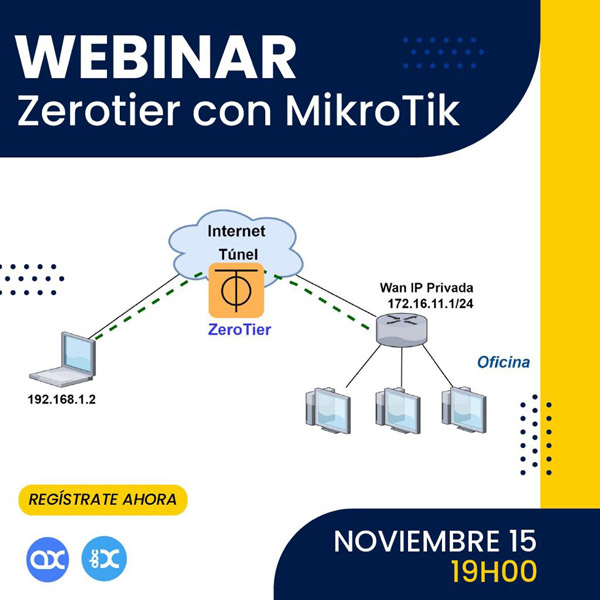Which is better PPPoE or static IP addressing for clients on an ISP network?
The general recommendation is to use static addressing for users of a WISP/ISP network due to the size of these networks, which are comprised of multiple nodes. Wanting to work with PPPoE in a WISP/ISP network requires that the network structure be flat (Layer 2), which is not recommended.
The choice between PPPoE (Point-to-Point Protocol over Ethernet) and static IP addressing for users or clients of an ISP (Internet Service Provider) network depends on several factors, including network management needs, the scale of service, customer expectations and existing infrastructure.
Each method has its advantages and situations in which it is preferable:
PPPoE (Point-to-Point Protocol over Ethernet)
Advantages:
- Session Management: PPPoE allows ISPs to manage individual user sessions efficiently, facilitating bandwidth management, monitoring, and usage-based billing.
- Authentication: Provides a built-in mechanism for user authentication, helping to ensure that only authorized clients can access services.
- Dynamic IP Assignment: Although PPPoE can be used in conjunction with static IPs, it is commonly used to assign IP addresses dynamically, allowing for more flexible management of the IP address space.
Disadvantages:
- Client Configuration: Requires client-side configuration, which can complicate initial installation or technical support.
- Overload: Introduces some overhead into the packet due to PPP encapsulation, which may slightly impact performance.
Static IP Addressing
Advantages:
- Ease: Offers a simpler and more direct network configuration for both the ISP and the client, since the client's IP address does not change.
- Remote Access and Services: Ideal for clients requiring constant remote access or hosting publicly accessible services, such as mail or web servers, where a fixed IP address is essential.
- Performance: There is no additional overhead associated with encapsulation, as is the case with PPPoE.
Disadvantages:
- IP Address Management: It can be more complicated to manage a limited pool of IP addresses, especially for ISPs with many clients.
- Lack of Integrated Authentication: Does not provide an authentication mechanism for users, which may require additional solutions to secure network access.
Conclusion
- PPPoE It is best for ISPs that need advanced user management, authentication and dynamic IP assignment. It is especially useful in environments where flexibility and control over the user session are important.
- Static IP It is preferable for applications that need constant connectivity and do not change, such as hosted servers, or for business users who rely on fixed remote accessibility.
The choice between PPPoE and static IP really depends on the specific needs of the ISP and its users. In some cases, ISPs offer both types of connections to satisfy different market segments.
There are no tags for this post.- Share this Article










4 comments on “Which is better PPPoE or static IP addressing for clients of an ISP network?”
How is a flat network structure required for PPPoE? The BRAS that provides the PPPoE service can be communicated to the EDGE of the network by any dynamic routing protocol and any type of network complexity that is required can be presented here. implement.
Dear,
A flat network (layer two) is required when the network is divided into several nodes which would like to be managed centrally, in that case the network must be layer two so that the server can reach the PPPoE clients. The other scenario is when the network is at layer three (routed) there it is assumed that the nodes have their administration router, if this is the scenario then PPPoE Servers could be applied in these routers so that each node can manage the clients it corresponds to them. While it is true that this is a good option for these nodes to be reachable, the application of some routing protocol would be required so that they can be managed from any point on the network. Both scenarios are functional, layer two gives you the possibility of having all clients centralized in a single router, however the most notable disadvantage is that being at layer two, the broadcast would begin to generate problems within the network since the tunnel PPPoE works at layer 2. While at layer 3 you would not have centralized clients since they would be divided by nodes and each node would have its own PPPoE server, however it would not have massive broadcast on your network since it is managed node by node now In this scenario, a Radius Server could be added so that clients do not log in and are managed individually and do so centrally, there you can solve this problem.
Regards,
Hello!! I have a pppoe connection to play online and it is still not the best, would a fixed IP address be better? I hope someone can explain to me, greetings!!
The tunnels, in this case PPPoE, work in the process of first disassembling each packet to later reassemble it but adding a certain amount of bits specific to the type of tunnel being used, so the packet suffers from 2 delays: the first when it has to be defragmented, and the second when it has to be reassembled. But in addition to that, the tunneling protocol must cache packets that could not be assembled previously, so that it can be reassembled into the next packet. This happens in each and every one of the packets that must circulate through that tunnel.
With all this in mind, it can be understood that the use of PPPoE definitely reduces performance considerably in applications that require real-time interactions such as video games. And if ! …it is much better to work in a non-tunnel environment, with a static IP.